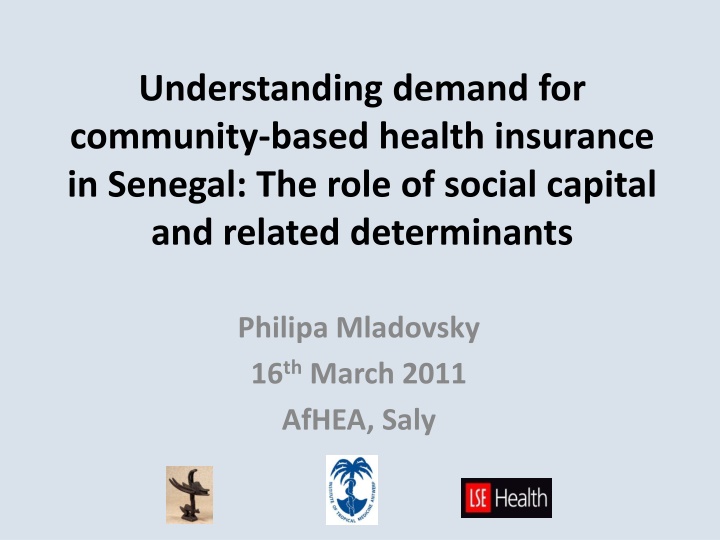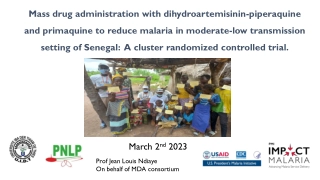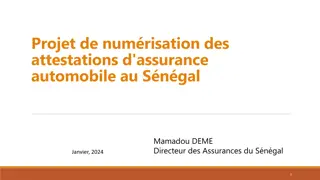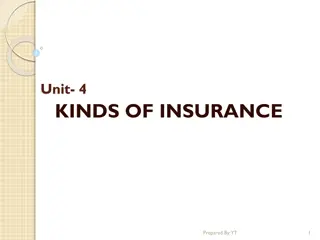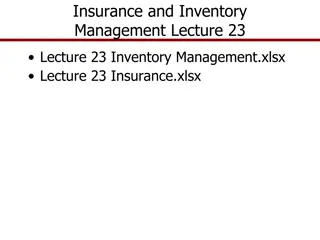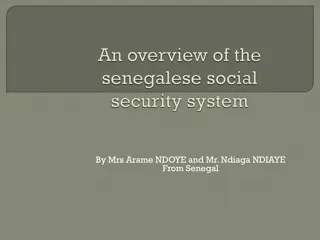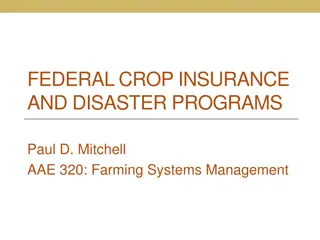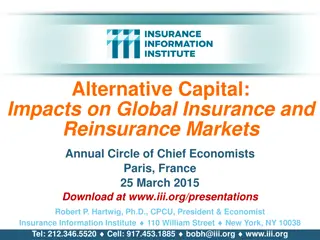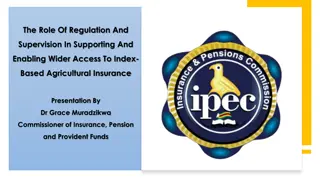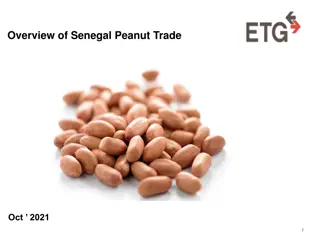Community-Based Health Insurance in Senegal: Role of Social Capital
This study delves into the demand for community-based health insurance in Senegal and the factors influencing it, such as social capital. It explores the necessity of prepayment mechanisms to reduce out-of-pocket health expenses, highlighting the features and growth of CBHI schemes while addressing the challenges of limited population coverage.
Download Presentation

Please find below an Image/Link to download the presentation.
The content on the website is provided AS IS for your information and personal use only. It may not be sold, licensed, or shared on other websites without obtaining consent from the author.If you encounter any issues during the download, it is possible that the publisher has removed the file from their server.
You are allowed to download the files provided on this website for personal or commercial use, subject to the condition that they are used lawfully. All files are the property of their respective owners.
The content on the website is provided AS IS for your information and personal use only. It may not be sold, licensed, or shared on other websites without obtaining consent from the author.
E N D
Presentation Transcript
Understanding demand for community-based health insurance in Senegal: The role of social capital and related determinants Philipa Mladovsky 16thMarch 2011 AfHEA, Saly
Outline Background to CBHI in LMIC Aims of study and methods Results Conclusions
Why is community based health insurance (PHI) needed in low and middle income countries (LMIC)? OOP on health: between 30 40% for all LMIC regions except South Asia where around 50% High levels of OOP reduce access to health care, especially among the poorest, and increase catastrophic expenditure Need to reduce OOP by developing prepayment mechanisms: what form should these take?
CBHI CBHI provides financial protection from the cost of seeking health care at the point of use. Three main features: prepayment of a premium for health services by individuals or families; community control (NGOs, religious, womens organisations etc) and voluntary membership
Rapid growth of CBHI schemes Countries 1997 2000 2003 Estimation 2006 B nin 11 23 42 120 Burkina Faso 6 26 35 60 Cameroun 18 20 22 30 C te d'Ivoire 0 29 36 47 Guin e 6 27 55 90 Mali 7 22 51 102 Mauritanie 0 0 3 5 Niger 6 12 9 19 Senegal 19 29 79 130 Tchad 3 4 7 11 Togo 0 7 9 12 Total 76 199 348 626 Source : Inventaires de la Concertation (www.concertation.org)
But limited population coverage 95% of the schemes have fewer than 1000 members so under 1 million people enrolled in 11 African countries in 2006 is CBHI a viable policy option?
Aims of study Understand demand (or lack thereof) for CBHI Existing conceptual frameworks: a) Neo-liberal economic framework Focuses on e.g. willingness-to-pay, information, quantity & price (Dror, 2001; Pauly, 2004; Preker, 2004; Zweifel, 2004) b) Institutional economics or health system framework Focuses on broader institutional context, analyzing e.g. interactions between insureds, insurance schemes, health service providers and the state (Bennett, 2004a, 2004b; Criel et al., 2004; ILO, 2002)
Limitations of the conceptual frameworks Both models arebased on concept of rational utility maximizing homo economicus Rational individualist model does not systematically explain the effect of social context on CBHI
What is social capital? Definition debated but useful starting point: the information, trust and norms of reciprocity inhering in one s social network (Woolcock, 1998):153 Empirical studies suggest that higher levels of social capital are positively correlated with improved development outcomes the missing link ?
MUCAPS case studies % current members Number of members* (house- holds) & % population coverage Estimated target populatio n (house- holds) CBHI scheme and region Membershi p fee and premium Year of initiatio n Geographic context Membership profile Benefits 20% 1. Soppante Rural, covers several districts Formal and informal sector workers Mixed ethnicities Mixed religions Primary care Secondary care 1,000 CFA family membership card 985 (30%) 3,333 1997 (Thies) 200 CFA / month / beneficiary 29% 1,000 CFA family membership card 2. Ndondol Rural, covers one district Agricultural sector One ethnic group (Serer) Mixed religions Linked to a micro-credit scheme Primary care 464 (21%) 2,166 2001 (Diourbel) 150 CFA / month / beneficiary 41% 1,000 CFA family membership card 3. Wer Ak Werle Urban / peri-urban, covers 2 districts Mainly women Petty traders Associational membership Mixed ethnicities Mixed religions Primary care 678 (5%) 13,604 2000 (Dakar) 200 CFA / month / beneficiary *Includes current members and ex members
Methodology Household survey Stratified sampling: Soppante Ndondol Wer Ak Werle NM M NM M NM M Sample 103 138 125 116 112 126
Soppante HH age <40 HH age 40-49 HH age 50-59 HH age 60-69 HH age >70 Female HH HH size <5 HH size 5-8 HH size 9-12 HH size 13-16 HH size >16 Polygamous HH Ex low Ex q2 Ex q3 Ex q4 Ex high Wealth low Wealth q2 Wealth q3 Wealth high HH no ed HH literate HH primary ed HH second ed Disability Chronic illness Recent illness Christian Muslim Mixed relig Wolof Poular Serer Mixed eth Other eth Assoc 0 Assoc 1-5 Assoc 6-10 Assoc increase Assoc stable Assoc decrease Contrib < 1.5 Contrib 1.5 - 7.4 Contrib > 7.5 Godparent Homonym Lend money Borrow money Others distant Others close Others v close Control decision low Control decision 2 Control decision 3 Control decision 4 Control decision high Cooperation low Cooperation med Cooperation high Trust low Trust 2 Trust 3 Trust 4 Trust 5 SC1 1.00 0.29* 0.16** 0.21** 0.16** 1.09 1.00 1.17 0.79 1.81 2.49 1.87 1.00 1.34 1.21 4.09** 5.75** 1.00 1.38 2.68* 2.76** 1.00 1.12 0.8 0.45 0.76 0.98 0.99 1.00 0.14 SC2 1.00 0.37 0.2** 0.27* 0.23** 1.06 1.00 1.08 0.64 1.37 1.89 1.84 1.00 1.43 1.54 3.35** 5.76 1.00 1.93 2.45* 2.65* 1.00 1.05 0.71 0.46 0.78 1.04 1.13 SC3 1.00 0.41 0.2** 0.33 0.24* 1.6 1.00 1.18 0.6 1.45 1.79 1.42 1.00 1.56 1.42 2.6* 5.26** 1.00 1.76 3.02* 2.58** 1.00 1.1 0.87 0.63 0.79 0.91 1.19 SC4 1.00 0.56 0.28* 0.5 0.32 1.45 1.00 1.22 0.68 1.93 2.2 1.33 1.00 1.48 1.55 3.05* 6.16** 1.00 1.61 2.08 2.41* 1.00 1.31 1.17 0.69 0.79 1.05 1.08 SC5 1.00 0.57 0.35 0.53 0.32 1.18 1.00 0.99 0.69 1.4 2.56 1.03 1.00 1.67 1.52 3.77** 6.16** 1.00 1.86 2.67* 2.37* 1.00 1.15 0.96 0.49 0.71 0.96 1.03 SC6 1.00 0.11** 0.05*** 0.07** 0.04*** 1.73 1.00 1.46 0.91 2.97 3.54 1.64 1.00 2.11 1.44 4.33** 6.73** 1.00 1.15 2.44 2.19 1.00 1.32 0.73 0.35 0.82 1.5 0.78 SC7 1.00 0.1** 0.05*** 0.05*** 0.05*** 1.53 1.00 1.09 0.79 1.86 3.02 1.29 1.00 2.46 1.69 3.67** 7.94*** 1.00 1.68 2.25 3.62 1.00 1.07 0.83 0.31 0.8 1.09 1.04 SC8 1.00 0.34 0.19** 0.25** 0.19** 1.31 1.00 1 0.69 1.44 2.05 1.66 1.00 1.46 1.61 3.39** 5.76 1.00 1.72 2.58** 2.55* 1.00 1.08 0.82 0.57 0.8 1.17 1.01 SC9 1.00 0.41 0.23** 0.3* 0.25* 1.13 1.00 0.96 0.53 1.27 1.39 1.75 1.00 1.52 1.54 3.45** 4.86** 1.00 2.05 2.6** 3.05** 1.00 1 0.73 0.58 0.82 0.97 1.05 SC10 1.00 0.42 0.22** 0.29* 0.24** 1.34 1.00 1.04 0.65 1.35 1.95 1.7 1.00 1.43 1.43 3.26** 5.69** 1.00 1.76 2.99** 2.54* 1.00 1.02 0.88 0.65 0.86 1.16 1.01 SC11 1.00 0.44 0.25** 0.34 0.28* 1.41 1.00 0.8 0.53 1.17 1.59 1.96 1.00 1.46 1.41 3.17** 6.14*** 1.00 2.03 2.85** 2.91** 1.00 1.18 0.98 0.75 0.83 1.1 1.14 SC12 1.00 0.44 0.27** 0.31* 0.27* 1.51 1.00 0.89 0.54 1.25 1.59 1.6 1.00 1.4 1.32 2.95** 5.24** 1.00 2.07 2.95** 2.69** 1.00 1.04 0.84 0.7 0.91 1.25 0.94 SC13 1.00 0.53 0.25** 0.3* 0.26* 1.2 1.00 0.91 0.72 1.8 2.29 1.61 1.00 1.32 1.44 3.41** 8.67*** 1.00 2.32 2.43* 3.03** 1.00 1.22 0.83 0.69 1.07 1.19 1.14 Significant results: Household level: HH age Expenditure Wealth Membership of associations Expenditure on associations 1.00 1.11 1.71 1.76 0.15 Individual level: 1.00 4.67** 47.9*** 1.00 1.18 1.59 Is a godparent Has homonyms Believes cooperation likely 1.00 1.22 3.09* 3.85*** 5.69*** 1.16 1.55 1.00 2.47 2.89 1.00 0.99 2.35 1.43 1.76 1.00 2.11 3.16* 1.00 0.74 0.42 0.52 0.87
Ndondol HH age <40 HH age 40-49 HH age 50-59 HH age 60-69 HH age >70 Female HH HH size <5 HH size 5-8 HH size 9-12 HH size 13-16 HH size >16 Polygamous HH Ex low Ex q2 Ex q3 Ex q4 Ex high Wealth low Wealth q2 Wealth q3 Wealth high HH no ed HH literate HH primary ed HH second ed Disability Chronic illness Recent illness Christian Muslim Mixed relig Wolof Poular Serer Mixed eth Other eth Assoc 0 Assoc 1-5 Assoc 6-10 Assoc increase Assoc stable Assoc decrease Contrib < 1.5 Contrib 1.5 - 7.4 Contrib > 7.5 Godparent Homonym Lend money Borrow money Others distant Others close Others v close Control decision low Control decision 2 Control decision 3 Control decision 4 Control decision high Cooperation low Cooperation med Cooperation high Trust low Trust 2 Trust 3 Trust 4 Trust 5 SC1 1.00 1.2 2.28 1.31 5.31** 1.01 1.00 0.64 2.16 2.34 3.33 0.59 1.00 1.55 0.74 1.27 1.35 1.00 0.86 2.3** 1.78 1.00 1.63 1.27 6.29 1.91 1.05* 0.71 1.00 0.2** 0.15** SC2 1.00 1.09 1.81 1.07 4.76** 1.24 1.00 0.59 1.72 1.89 2.95 0.77 1.00 1.42 0.69 1.4 1.27 1.00 0.89 2.25** 1.94 1.00 1.47 1.15 5.21* 2.26* 1.13 0.76 SC3 1.00 1.33 2.36 1.39 5.67*** 0.98 1.00 0.59 1.76 2 2.81 0.63 1.00 1.59 0.7 1.29 1.26 1.00 0.86 2.13* 1.8 1.00 1.58 1.43 5.78* 1.96 0.97 0.71 SC4 1.00 1.63 2.93* 2.05 7.57 1 1.00 0.39 1.26 1.51 2.21 0.75 1.00 1.6 0.75 1.39 1.47 1.00 0.89 1.89 1.82 1.00 1.7 1.37 6.94** 2.18 0.9 0.65 SC5 1.00 1.43 3.28** 1.48 8.15 0.77 1.00 0.08 0.2 0.22 0.26 0.66 1.00 1.48 0.79 1.26 1.17 1.00 0.82 1.94 2.02 1.00 1.96 1.33 4.27 2.33 0.9 0.74 SC6 1.00 1.22 2.12 1.26 4.39** 0.88 1.00 0.77 2.32 2.77 3.88 0.56 1.00 1.56 0.65 1.29 1.22 1.00 0.92 2.14 1.68 1.00 1.56 1.33 6.29* 2.16 0.97 0.72 SC7 1.00 1.41 2.45 1.46 5.35** 0.98 1.00 0.6 1.99 2.3 2.98 0.59 1.00 1.61 0.74 1.25 1.44 1.00 0.85 2.11* 1.84 1.00 1.52 1.25 5.99* 2.01 1 0.74 SC8 1.00 1.27 2.22 1.31 5.48*** 1.06 1.00 0.6 1.98 2.21 3.05 0.63 1.00 1.57 0.71 1.31 1.37 1.00 0.89 2.13* 1.75 1.00 1.59 1.32 5.72* 1.94 1 0.69 SC9 1.00 1.09 2.2 1.24 5.57*** 1.11 1.00 0.59 1.86 2.13 2.59 0.63 1.00 1.53 0.71 1.29 1.2 1.00 0.77 2.19* 2.07 1.00 1.59 1.14 6.15* 1.76 1 0.68 SC10 1.00 1.35 2.25 1.48 6*** 1.11 1.00 0.63 2.16 3.07 4.58 0.63 1.00 1.93 0.79 1.8 1.96 1.00 0.89 2.3** 1.76 1.00 1.51 1.35 6.51** 2.1 0.87 0.67 SC11 1.00 1.35 2.36 1.48 6.21*** 0.88 1.00 0.62 1.8 2.23 3.32 0.67 1.00 1.42 0.75 1.41 1.4 1.00 0.89 2.39** 2.06 1.00 1.44 1.44 5.43* 2.15 0.99 0.72 SC12 1.00 1.32 2.41 1.36 5.36** 0.98 1.00 0.57 1.96 2.43 3.06 0.64 1.00 1.63 0.78 1.42 1.4 1.00 0.79 2.2* 1.73 1.00 1.56 1.41 6.65** 1.99 1.01 0.69 SC13 1.00 1.41 2.3 1.3 4.88** 0.78 1.00 0.59 2.12 2.43 2.82 0.58 1.00 1.77 1.04 1.55 1.62 1.00 0.72 2.59** 2.11 1.00 1.58 1.39 4.28 1.88 1.16 0.78 Significant results: Household level: HH age Wealth HH education Religion 1.00 Individual level: 1.32 0.93 1.00 1.26 1.43 Borrowing money Feeling close to others in village Control over decisions made in the village 1.00 0.52 0.48 1.00 1.5 0.49 1.63 1.13 1.4 1.81* 1.00 0.64 0.37* 1.00 1.34 3.36** 1.19 1.08 1.00 1.78 1.26 1.00 1.67 0.62 1.44 2.25
Wer Ak Werle HH age <40 HH age 40-49 HH age 50-59 HH age 60-69 HH age >70 Female HH HH size <5 HH size 5-8 HH size 9-12 HH size 13-16 HH size >16 Polygamous HH Ex low Ex q2 Ex q3 Ex q4 Ex high Wealth low Wealth q2 Wealth q3 Wealth high HH no ed HH literate HH primary ed HH second ed Disability Chronic illness Recent illness Wolof Poular Serer Mixed eth Other eth Christian Muslim Mixed relig Assoc 0 Assoc 1-5 Assoc 6-10 Assoc increase Assoc stable Assoc decrease Contrib < 1.5 Contrib 1.5 - 7.4 Contrib > 7.5 Godparent Homonym Lend money Borrow money Others distant Others close Others v close Control decision low Control decision 2 Control decision 3 Control decision 4 Control decision high Cooperation low Cooperation med Cooperation high Trust low Trust 2 Trust 3 Trust 4 Trust 5 SC1 1.00 1.01 1.2 1.37 0.8 0.66 1.00 1.38 1.06 3.93* SC2 1.00 0.98 1.15 1.27 0.76 0.68 1.00 1.24 0.91 3.07* SC3 1.00 1.12 1.25 1 0.6 0.63 1.00 1.21 0.89 4.24* SC4 1.00 0.96 1.33 1.55 0.76 0.77 1.00 1.15 0.88 2.68 SC5 1.00 1.13 1.36 1.59 0.63 0.44** 1.00 1.8 0.98 2.61 SC6 1.00 0.95 0.94 0.97 0.68 0.6 1.00 1.02 0.87 2.42 SC7 1.00 1 1.11 1.24 0.74 0.63 1.00 1.03 0.8 2.32 SC8 1.00 1.05 1.18 1.33 0.8 0.66 1.00 1.35 1.03 3.54 SC9 1.00 1 1.11 1.32 0.77 0.62 1.00 1.13 0.75 2.5 SC10 1.00 1.01 1.16 1.28 0.74 0.65 1.00 1.06 0.76 2.66 SC11 1.00 0.96 0.84 1.5 0.6 0.63 1.00 1.37 1.01 3.18 SC12 1.00 1.08 1.25 1.63 0.79 0.7 1.00 1.06 0.72 2.97 SC13 1.00 1.08 1.22 1.38 0.77 0.77 1.00 1.14 0.81 3.62* Significant results: 0.34 1.00 0.97 1.3 1.29 2.93* 1.00 0.56 0.76 1.19 1.00 0.56 0.79 1.22 1.44 0.68 1.88* 1.00 1.24 0.86 0.62 0.31** 0.44 1.00 1.11 1.38 1.42 2.95** 1.00 0.55 0.81 1.00 1.00 0.46 0.74 0.98 1.59 0.7 2.01* 0.3 1.00 0.98 1.35 1.24 2.28 1.00 0.4** 0.67 0.66 1.00 0.41* 0.7 1.11 1.05 0.62 2.42** 0.45 1.00 1.02 1.41 1.32 2.68* 1.00 0.5* 0.76 0.91 1.00 0.4* 0.68 0.96 1.37 0.75 1.91* 0.43 1.00 0.72 1.36 0.7 1.87 1.00 0.49 1.27 0.93 1.00 0.48 0.55 1 1.46 0.6 2.88** 0.41 1.00 1.34 1.06 1.34 2.29 1.00 0.59 0.88 1.22 1.00 0.53 0.72 0.84 1.36 0.68 2.43** 0.42 1.00 1.18 1.18 1.31 2.4 1.00 0.57 0.84 1.23 1.00 0.49 0.7 0.89 1.72 0.7 2.3** 0.45 1.00 1.09 1.44 1.45 3.07** 1.00 0.57 0.8 1.03 1.00 0.47 0.68 1.01 1.65 0.7 2.14** 0.43 1.00 1.19 1.33 1.28 2.36 1.00 0.57 0.91 0.96 1.00 0.45 0.72 1.12 1.33 0.63* 2.03* 0.42 1.00 1 1.43 1.27 2.75* 1.00 0.5* 0.79 0.94 1.00 0.44 0.73 0.95 1.79 0.68 2.15** 0.43 1.00 0.87 1.38 1.03 2.61* 1.00 0.5* 0.79 1 1.00 0.41* 0.57 0.72 2.23 0.7 1.85 0.44 1.00 1.22 1.54 1.43 3.11** 1.00 0.51 0.86 1.03 1.00 0.4* 0.63 1.07 1.44 0.68 2.03* 0.48 1.00 1.02 1.63 1.43 3.71** 1.00 0.55 0.93 0.99 1.00 0.49 0.67 0.9 2.17 0.7 1.99* Household level: Size Expenditure Wealth Education Recent illness Ethnicity Membership of associations Number of associations 1.00 2.18 1.00 6.58*** 18*** 1.00 0.74 0.21** 1.00 1.21 1.46 Individual level: Borrowing money Control over decisions 1.22 1.06 0.66 2.52*** 1.00 0.84 1.48 1.00 1.99 2.87** 4.32*** 5.57*** 1.00 1.79 1.91 1.00 1.24 0.3 0.73 0.71
The role of social capital? Social capital seems to play a different role in different types of CBHI scheme Explained by social structure of schemes? Soppante: heterogeneity of members and large size of scheme attracts people with wider social networks, more trust & norms of generalised reciprocity social capital important determinant of enrolment Ndondol: homogeneity of members, rural context and small size of scheme existing solidarity, information and norms of reciprocity between target population social capital less important determinant of enrolment Wer Ak Werle: heterogeneity of members, urban context and large size of scheme is counteracted by existing solidarity of women s group enrolment mechanism. Control over decisions and membership of associations probably explained by enrolment strategy. Qualitative results indicate this has potential to influence quality of care.
Tentative policy implications Members of CBHI have greater social capital (more extensive social networks and greater reciprocity and solidarity) than non-members in some contexts Direction of relationship not clear but probably SC is a cause, not effect of enrolment (qualitative data will help clarify)
Tentative policy implications CBHI schemes should utilise existing social capital to increase and retain membership numbers (eg enrolment through existing associations) CBHI schemes should develop strategies to target groups with low social capital who are possibly not only economically but also socially excluded from initiatives to improve access to health care
